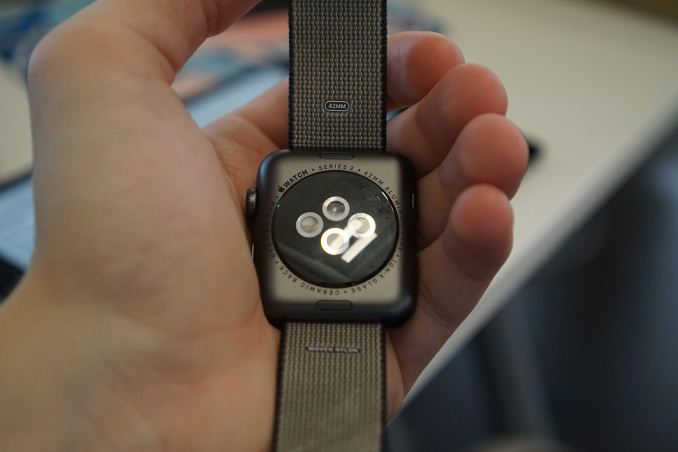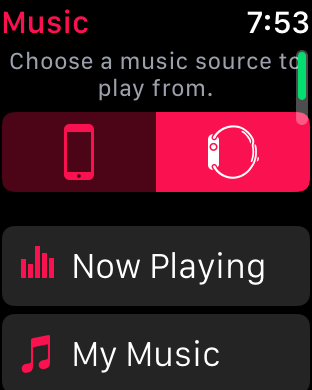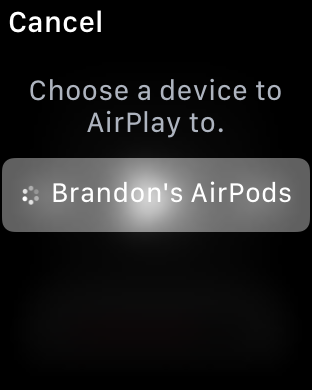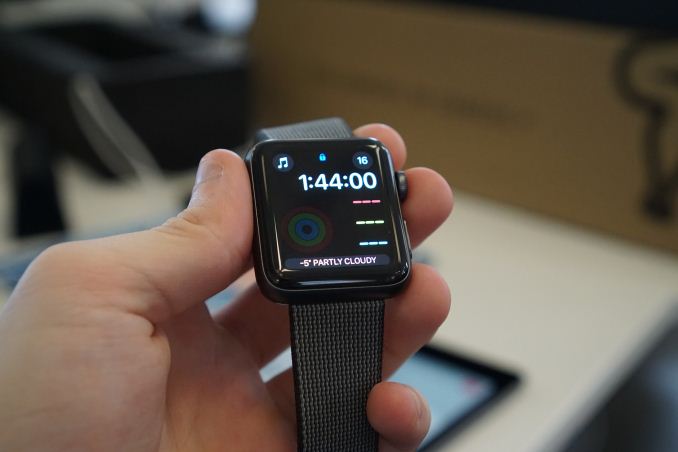The Apple Watch Series 2 Review: Building Towards Maturity
by Brandon Chester on December 20, 2016 8:00 AM EST- Posted in
- Wearables
- Apple
- Apple Watch
- Apple Watch Series 2
Final Words
In many industries, but especially in technology, there's a common wisdom about waiting for the second or third iteration of a product before purchasing it. This is based on the idea that the first version of a product will often be the most flawed or compromised - a product still trying to find its footing - and future iterations will benefit from improved technology, as well as fixes for flaws that were found in early versions. At the same time, there have to be some people who are adventurous enough to adopt bleeding-edge technology, or the first version of a product would simply fail in the market and there wouldn't ever be a second version.
This situation has played out for every iOS and iOS-derived device that Apple has created. The original iPhone was quite a technological marvel, but it was crippled by its lack of 3G networking, and its price was exceptionally high. With the iPhone 3G and 3GS, Apple addressed many of the issues that existed with the iPhone 2G, and by the time of the iPhone 4 the refinement was essentially at the same level that we expect from smartphones today. The original iPad was an interesting idea, but it was quick thick and heavy, and the hardware used at the time was not up to the task of powering such a device, sending it to end of life status after only two major updates. Only one year later, the iPad 2 addressed both of these issues, future versions brought faster hardware and higher resolution displays, and by the time of the iPad Air it reached a level of refinement where further versions have been much more iterative changes.
The first Apple Watch was definitely in the same situation as the iPhone 2G and the iPad 1. It was the first version of a brand new product, bound by serious hardware limitations and many unknowns about how consumers would come to use it. Like the iPad 1 it has received two major OS updates, and I don't expect it to go any farther. I talked earlier about how Apple had an idea of how the Apple Watch would be used, but clearly overestimated the appeal of some aspects and underestimated the appeal of others. The Apple Watch Series 2 focuses more on these aspects such as fitness with its GPS and true waterproofing, while watchOS 3 fixes many of the software issues that existed in the previous two versions.
The Apple Watch is still very much a companion to the iPhone. Even with the addition of GPS, it isn't close to being able to stand on its own. You can avoid bringing along the paired iPhone for workouts, and the watch can pull data from the network in some cases using its built in WiFi, but in general having the iPhone nearby is a requirement to actually do anything. Bringing cellular to the Watch would make it significantly less-dependent on the iPhone, but that also comes with a power and a space penalty, both of which are heavily constrained with a smartwatch.
Even if Apple were to bring cellular to the Apple Watch, I question how beneficial it would be for the experience given the two drawbacks I mentioned above. I can't think of many cases where I don't actually have my phone, so I don't know why I'd pay to maintain an additional cellular line for my watch when my phone was usually available to handle network activity. Additionally, adding cellular wouldn't remove the tight connection between the two devices, as the Apple Watch's settings and backups exist on the paired iPhone, and all of its applications are extensions of iPhone apps. This model makes it clear to me that Apple isn't planning to make the Apple Watch a standalone device any time soon.
As a companion to the iPhone, the Apple Watch works quite well. For me the Apple Watch is a timepiece, a hub for relevant information and notifications, a music player, and a health and fitness tracker. I've long since gotten used to having something on my wrist, and in fact I find myself checking my bare wrist out of habit when I've taken the Apple Watch off. Being able to check the time, the weather, the date, and other information simply by raising your wrist is just a convenience, and it's nothing your iPhone can't do as well, but it's a convenience that I wouldn't want to give up now that I have it.
Using Apple Watch as a music player is probably a more niche use case, but it does apply to me. It really seems like the natural replacement of the current iPod Nano, which is of a similar size. Of course, there's no headphone jack, but I've been using Bluetooth headphones for seven years so that doesn't present a problem for me personally. Even if you use your iPhone for music, the Apple Watch provides a quick way to access playback controls, especially if you have the Music application set as a complication or kept in the Dock. I suspect that more users will end up utilizing the standalone Music playback abilities of the Apple Watch now that the AirPods are shipping to consumers, but only time will tell.
Last, but not least, are the Apple Watch's health and fitness tracking abilities. When the Apple Watch first launched I thought I would just turn these off and forget about them, but my own poor health choices have led to me relying on them to keep myself on track. Having something constantly monitoring me is essential in figuring out how many calories I'm burning on a daily basis, which is how I decide what I'm going to eat. Workouts also provide me with various statistics about my jogging and cycling that I had always wondered about but had never been able to track. As the days get colder, having the Activity rings on the watch face is also a constant reminder that I need to keep active even if I'm staying inside to keep warm. Many of these things basically come down to the Apple Watch pointing out flaws in my personality that I won't improve of my own volition, and I'm okay with that because it produces results.
While I'm talking about the core aspects of the current Apple Watch experience, it does bear repeating that some things that Apple thought would be a big part of the experience have really fizzled out. I haven't found myself using it as a communication device except for taking phone calls, and Apple has de-emphasized communication as a feature in watchOS 3 accordingly, so I expect I wasn't alone. Similarly, I think issues with watchOS and the original Apple Watch's hardware have damaged the image of the Apple Watch as an app platform, and as someone who used the original I really haven't gotten used to using applications because in the past they just never worked.
As for development, I think it's fair to say that the Apple Watch hasn't yet proven itself as a developer platform. However, WatchKit is a really interesting and well thought out API for designing and developing apps for the smartwatch form factor. Despite the quality of the API itself, there's clearly still uncertainty over what an Apple Watch app should even aspire to do. I think not making a watchOS app at all is a valid decision for many iPhone applications, and that's an important decision for developers to make because it's an investment of time and money, and there are several applications that offer watchOS apps without any compelling functionality.
Ultimately, both watchOS and the Apple Watch are still in their early days, and the software will grow and improve over time as the hardware becomes faster and more efficient. The Apple Watch Series 2 really reminds me of the iPad 2. It tackles the areas where its predecessor faltered, and provides a much better experience as a result, but there's still that lingering early adopter feeling that even greater improvements are coming in the next generation. I would imagine that future series of the Apple Watch will bring additional sensors for tracking health information, thinner casings, and hopefully better battery life so features like sleep tracking will be possible. While there's always something to look forward to in future versions of a product, I think the Apple Watch Series 2 does provide a compelling experience right now, and for iPhone users interested in a fitness tracker or a smartwatch it should be high on your list of devices to consider.















126 Comments
View All Comments
negusp - Tuesday, December 20, 2016 - link
IMO, I think the wearable craze for premium wearables has/is fading quickly. Full-fledged smartwatches are simply not attractive to the normal consumer.When you can spend $50 for an entry level wearable that lasts for a few days, reports the time, measures fitness activity, why purchase a $400 Apple Watch that only has the benefits of a screen and GPS (which your phone is for)?
Ironchef3500 - Tuesday, December 20, 2016 - link
+1GodHatesFAQs - Tuesday, December 20, 2016 - link
I was never interested in any wearables, but now almost everyone in my family is. This Christmas most people bought Apple Watches. Not sure what the appeal is.Lolimaster - Tuesday, December 20, 2016 - link
Let the doctor tell them about the problem with their necks, fad gone.tipoo - Tuesday, December 20, 2016 - link
I havn't followed this segment much at all - what are the 50 dollar wearables that do all that? That would be far more in impulse buy territory, I think they have some utility, but not 350+USD utility.
ianmills - Tuesday, December 20, 2016 - link
xiaomi mi band 2 is $40 is a possibility https://www.cnet.com/products/xiaomi-mi-band-2/rev...name99 - Tuesday, December 20, 2016 - link
That's not even a fitness tracker, it's basically a digital pedometer.Does it provide notifications? Voice control? Phone call support? Remote control of a phone camera? etc etc?
You're pointing to a bicycle and claiming it does the same thing as a Harley Davidson.
Cygni - Tuesday, December 20, 2016 - link
Good analogy, but remember that the vast majority of people already have a car (smartphone) that does everything a Harley can do but better. Ergo most people dont want to fork out big bucks Harleys. They do, however, want cheap bikes.heffeque - Wednesday, December 21, 2016 - link
This. Simply this.easp - Tuesday, January 3, 2017 - link
Yes, and most people had a computer that did everything a smartphone did, better, except fit in their pocket.